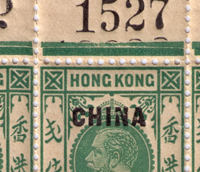Setting the Overprint
The plate for the ‘China’ overprint, applied by Somerset House, was compiled from a basic frame of 6 x 2 overprints. This was about half a millimeter too small both horizontally and vertically and varied in detail from printing to printing. This basic frame was used to make a complete plate of 240 and there are noticeable drifts both horizontally and vertically. This meant that on each sheet and within each pane, the setting of the overprint alternated between being 23 ½ mm and 24 ½ mm apart in each vertical row.
Varieties in the Overprint
A couple of varieties have been discovered over the years, the most noticeable of which was an upward slant to the word ‘China’ discovered on a single sheet of the 4c carmine-rose stamps from Requisition F, printed in February 1922. The slant became more evident towards the bottom of the sheet, such that the word is split between two adhesives on the bottom row 1.
Additionally, there are a few examples of stamps with the ‘China’ overprint much higher up in relation to the crown, which likely resulted from a misalignment of the sheet.
Other varieties include:
The 'Broken N' variety, as seen on the 2c sheet of Requisition I in position NW 1-4;

The 'Short A', shown here on the lower right stamp which appeared at SE 10-2 on the 50c Requisition H as well as on the 2c and 4c of Requisition I;
Finally and perhaps most interestingly, the 'Thin H' and 'Broken C' varieties.
In 1927, on the H printing, a variety of the overprint appeared where the left leg of the H in position NW 1-2 was noticeably thinned. To date, this had only been recorded on the Requisition H 50c, the Requisition I 2c and 4c, and the Requisition J 25c. The set of plate strips shown below is the first time that this variety has been found on the Requisition H $1 and $2 and can therefore prove that these are constant overprint flaws. In addition, position NW 1-3 shows a constant broken C on all three denominations, which leads to speculation that this is a previously unrecorded variety as well.





